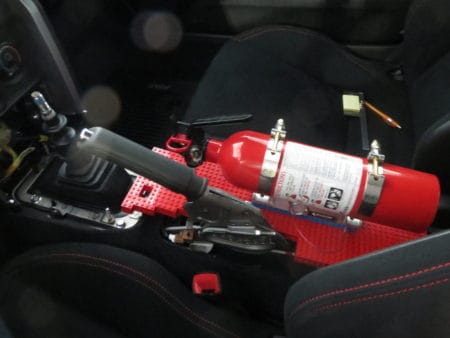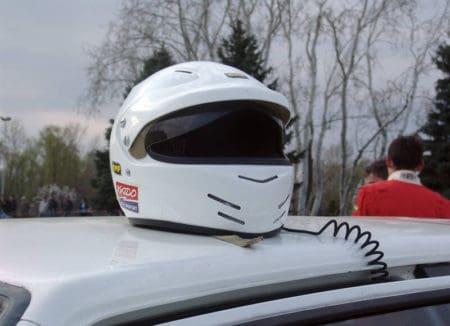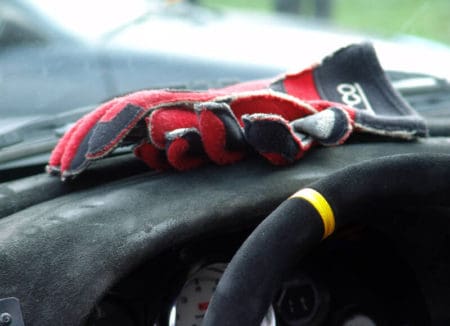Drifting certainly isn’t the easiest sport out there, nor is it the safest. When you’re behind the wheel, anything could happen. Your tires could pop (and probably will). You could throw a rod. Your engine could light on fire if you develop a fuel or vacuum leak. You could crash into someone doing tandem, or get crashed into doing tandem. You have to be ready for just about anything when you’re on the track.
While I can’t prevent the damage, what I can do is give you the tools to stay safe. Whether it’s a fire extinguisher, a helmet, or a set of gloves, each item will help keep you safe in its own way.
(NOTE: Images aren’t of actual items, just of similar ones. Thanks, Amazon! lol)
Fire Extinguisher
 Not to be confused with a Fire Distinguisher (which just tells you whether it’s fire or not), the Fire Extinguisher is crucial to have in any high-performance car. With lots of fuel and lots of booms comes lots of heat, and if something flammable gets too close to your motor.. You’ve got a fire really fast. While not all track days require every car to have an extinguisher, it is highly recommended. A small electrical fire could easily be put out, lest it consume your car.
Not to be confused with a Fire Distinguisher (which just tells you whether it’s fire or not), the Fire Extinguisher is crucial to have in any high-performance car. With lots of fuel and lots of booms comes lots of heat, and if something flammable gets too close to your motor.. You’ve got a fire really fast. While not all track days require every car to have an extinguisher, it is highly recommended. A small electrical fire could easily be put out, lest it consume your car.
You could always try to pat out the fire with your gloves (see below), however, this is incredibly dangerous to attempt. A fire extinguisher is quite simply the best option, and the safest. Commonly, people mount them to the roll cage in the car (if you have one) on the ceiling, or in the passenger floorboards. Somewhere within reach is important, though.
Helmet (Open-Face or Closed-Face)
 In your car, a harness and bucket seat isn’t enough to keep you entirely safe. In the event of a crash, parts could come flying off cars and hit you, or the whiplash in your neck from the impact itself. With a helmet on, however, you can protect yourself from any flying debris. On top of that, a helmet in a bucket seat will reduce the lash in your neck.
In your car, a harness and bucket seat isn’t enough to keep you entirely safe. In the event of a crash, parts could come flying off cars and hit you, or the whiplash in your neck from the impact itself. With a helmet on, however, you can protect yourself from any flying debris. On top of that, a helmet in a bucket seat will reduce the lash in your neck.
When I did motocross as a kid (like 5, really young), I had to wear a neck protector. The helmet was too heavy for my little neck, and with all the lashing from riding dirt bikes, I needed a pad between my helmet and my chest protector. An item like this would help even further with the lash in event of a crash.
Choosing a helmet is entirely up to you. I have been rocking my motocross helmet for awhile. Since I’m not going at high speed, the visor doesn’t cause any issues with turbulent air flows in the car. My helmet also has a communicator in it, so I can be talking with buddies on the sidelines, or my partner if I were to go tandem. Other people use closed-face helmets, where they have a built-in visor. They can also be fitted with communicators, and have the security of face protection. With an open-face helmet, though, there is no eye or face protection. It’s also rather uncomfortable to mount a communicator, as the mic will be hanging out front.
Gloves
 Now, keeping a car sideways is done mostly with your feet, but getting it sideways? That’s on your hands. Those hands need to be able to grip efficiently and quickly, and be able to slide along the wheel with little discomfort. Another scenario where gloves would be important is when you’re in the car, and a small electric fire starts. Wearing these fireproof gloves would allow you to pat out the fire, hopefully putting it out before any damage is done. Shifters and handbrakes also tend to get slippery once you’re in the car and sweating a lot, so having the extra grip would help a ton with input accuracy.
Now, keeping a car sideways is done mostly with your feet, but getting it sideways? That’s on your hands. Those hands need to be able to grip efficiently and quickly, and be able to slide along the wheel with little discomfort. Another scenario where gloves would be important is when you’re in the car, and a small electric fire starts. Wearing these fireproof gloves would allow you to pat out the fire, hopefully putting it out before any damage is done. Shifters and handbrakes also tend to get slippery once you’re in the car and sweating a lot, so having the extra grip would help a ton with input accuracy.

